Target Launches Gender-Neutral Home Décor for Kids


Earlier this month, Target announced its newest line: Pillowfort. A line designed strictly for kids, Pillowfort will hit stores by the end of February. And what’s unique about this product launch? The line is comprised of trendy items that are perfect for gender-neutral home décor.
In fact, this new product launch follows Target’s attempt this past August to be more gender neutral by removing the “boys” and “girls” signs that hung over the clothing and bedding sections of the store.
After careful research and questionnaires, the retailer's product-development team found that modern parents have grown weary of the inherently blue or pink aisles that separate the genders, noting that it’s no longer appropriate to assume that girls don’t like dinosaurs and boys don’t like horses. Boys – as we know – don’t always choose blue as their favorite color, and girls certainly don’t always choose pink.
So, Target found an opportunity to change and redefine its products to better suit the market. First with the removal of signage. And now, with Pillowfort.
The gender-neutral trend
The gender-neutrality trend isn’t a new one. This ad from the Lego Group depicting a girl using its building blocks appeared in 1981. She’s wearing blue jeans and a blue-striped shirt, her hair swinging over her shoulder in a braid. She’s strong, creative, and not dressed in sparkles and a pink ribbon. And while this ad shows a propensity for gender-neutrality, it stands in stark contrast to the highly criticized Lego Group branding from today, which includes a line of pink and purple building blocks 'for girls.'
So, what’s happened between 1981 and today? Why is it that ads like the ones for Lego Friends have come under fire in recent years? Is it because there’s been another wave of realization that girls and boys aren’t all that different when it comes to likes and interests?
What Target found is that branding such as the most recent from Lego is potentially damaging. Perhaps less strongly, it’s just not what appeals to every boy, girl or parent out there these days. The market is looking for something else. Gender-neutrality is it.
Gender-neutral bedding and décor for kids’ rooms has been – for several years now – something to be found among higher-end retailers like Land of Nod and Pottery Barn. The real difference? It may just come down to cost. Target’s version of gender-neutral merchandise will be attainable and affordable for the average American family.
The significance in kids’ home décor
Kids’ rooms are a lot more than just a place to sleep. These days, kids’ bedrooms are the inspirational foundation for the life ahead of them. This is why you’ll see décor pieces filled with encouragement interspersed throughout the Pillowfort line. Items gently push kids to “be you” and “be awesome today.”
And beyond encouragement, the Pillowfort line embraces self-expression, creating pieces that can be mixed and matched, jumbled and tossed, to create a unique look that defines the uniqueness of its smallest inhabitant.
And modern-day parents – alongside a desire to give their kids a positive foundation full of encouragement and self-expression to start their days off well – are looking at doing so with the ease of convenience, economy and with a special place for equality.
There is, it would seem, a definitive cry for gender-neutral décor that goes beyond what’s been done before. This is why many forward-thinking parents are using taupes, blues and grays to decorate nurseries and kids’ rooms. Neutrals, like gray, have versatile shades that accentuate other décor.
Throwing the mix-and-match Pillowfort collections into a neutral base of a room gives character and harkens to the skills of a professional designer. Easy, affordable, interchangeable, expressive, gender-neutral; these are the descriptors of this new line from Target.
This gender-neutral merchandise isn’t – it should be said – the end of blues and pinks or girly or boyish prints. For girls who want a pink room, there are still plenty of options out there. But there are a lot more choices out there for the girl who would rather choose a bold yellow, blue or red as her color of choice.
If you’re looking for gender-neutral, inspirational pieces for your kids’ rooms, look no further than the big red bullseye Target has made popular. There, at the end of the month, Pillowfort will be.
Image via Public Domain Archive
Simple, Transparent Fashion: 3 Brands to Watch
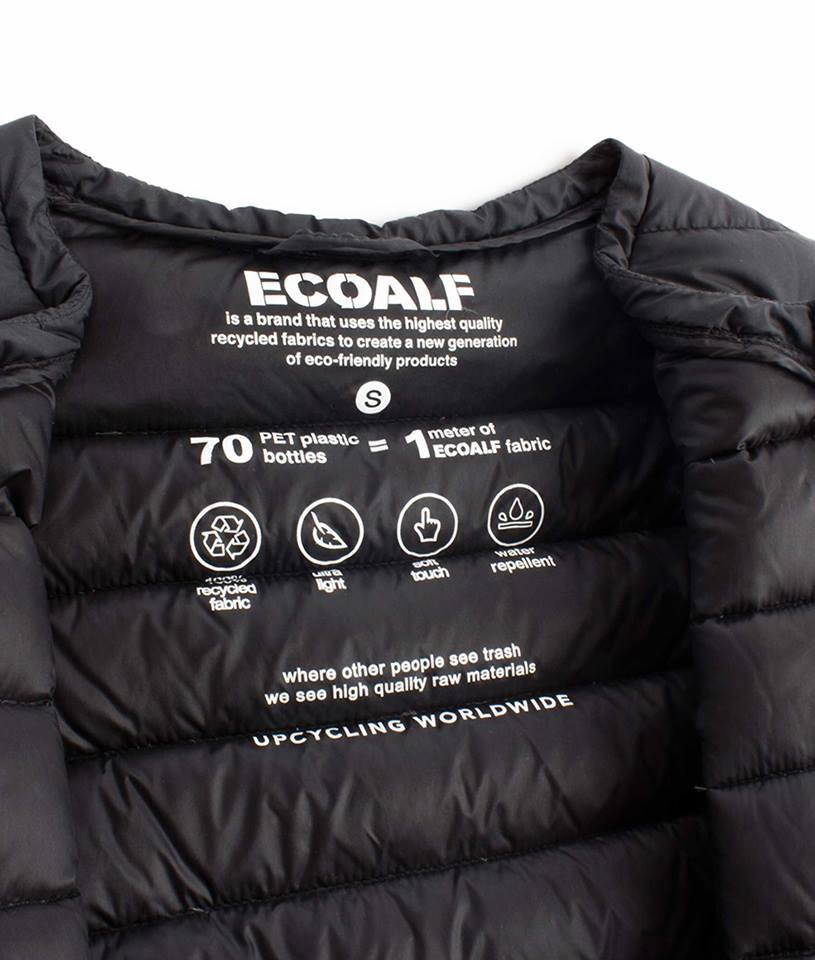

By Averill Brewer
There is something dignified about an individual who doesn’t care to air out his or her dirty laundry to anyone willing to listen. Concealing personal details can create a sort of tantalizing mysteriousness. For decades, firms have been able to keep their affairs moderately quiet and to appease the public’s curiosity through occasionally releasing PR-orchestrated details or reports about company relations. It’s not hard to maintain an opaque image as long as nothing too scandalous happens.
The Internet and social media, due to their viral propensity, have pretty much loosened the tight grasp on privacy that firms once held. Even if a company uses public relations and marketing to create a sleight-of-hand about the reality of its supply chains and operations, people still like to be fed that information. We’re nosy.
As a result, there is also something equally respectable about a business willing to bare it all to the public eye. Transparency, especially in the fashion industry, seems like a very vulnerable business tactic, unless, of course, you have nothing to hide. While not everyone may be that curious about the polyester suit they are purchasing, what it takes to make such a fabric, or how many chemicals were used to create that hue of blue, a company that wants to you to understand its relationship with that stuff definitely wins admiration.
Fashion companies that root their principles in sustainability and the circular economy from their conception are beginning to pop up globally. Below are three fashion brands that take varying approaches to transparently-led (sustainable) business strategies. In all examples, the company will be the first to admit that it doesn’t have everything perfect, and that kind of honesty rocks. Because the thing is: The more popular it becomes for companies to portray themselves transparently, the more stakeholders will demand producer responsibility and accountability from those that don’t.
You can only hide for so long. And if you’re just pretending, we’ll find out, too. In the end, damage control may be much more of an expensive hassle than getting it right the first time when it comes to sustainability, as Volkswagen recently displayed (with its 6.7 billion euro cost in recall fees, and the first quarterly loss in 15 years).
Reformation: Best All Around
Ladies … first and foremost: A woman named Yael Aflalo created Reformation in 2009, and 75 percent of the management team is now run by women.
Living by the statement that “fashion and sustainability coexist,” Reformation designs and manufactures most of its products in its own sustainable sewing factory in downtown Los Angeles. Certified B Corp? Check. Sustainable fabric sourcing? Check. Fair working conditions? Reduce, reuse, recycle as a waste-management policy? Low-impact transportation? Environmentally preferred purchasing policies across business offices and the use of recycled packaging? You know it. Literally, everything you could imagine checking off a checklist for positive sustainable business practices, Reformation has thought of and has incorporated into their business strategy.
One of the coolest programs about this company is RefRecyle, which was started because Americans throw away 68 pounds of clothing per person, per year. When you buy something online, the company includes a free RefRecyle shipping label. You can put it on a box and fill it up with whatever clothing you want to be recycled, and Reformation will take care of the rest.
The website is a steward of transparency. Read your heart out — you’ll want to — it’s extremely interesting. Click on the sweater you are interested in purchasing, and you will see a visual depiction of how much water was used in the process and how much CO2 was emitted to make that individual sweater. Genius. Side note: If Reformation is a bit out of your price range, check back for their seasonal sales.
ECOALF: Honorable Mention
This Spanish-based company plans to create the first generation of recycled products with the same quality, design and technical properties as the best non-recycled products, with an aim to show that there is no need to use our world’s natural resources in a careless way.
ECOALF sources plastic bottles that are cleaned and crushed vigorously and turned into plastic flakes, which is eventually converted into polyester fiber and then turned into a yarn. The “technical nutrient” system’s lovechild. Upcycle, baby!
Wearing plastic isn’t for everyone, but ECOALF has certainly created a selection of very handsome products, including: a selection of standard men's and women's down jackets (you can never have too many puffer jackets, right?), slick backpacks in shades of burgundy and deep navy, and shoes with soles made from re-purposed tires. Here you can read about other interesting processes used to make the company's products, exemplifying fashion industry transparency.
Aiayu: Honorable Mention
Founded by Maria Heilmann, Dutch company Aiayu values simplicity as the heart of its mission in fashion. The brand was created with just one material and one producer and strives to keep its concept simple and transparent.
Aiayu’s website provides pictures of the company’s value chain so that curious customers can understand the company’s processes like sourcing its raw material, fiber refinement, knitting, packaging, and shipping and transport. Additionally, it takes responsibility throughout the entire value change and ensures full transparency: The company only works with one manufacturer that covers the entire supply chain from sorting of fibers, dyeing, spinning and finishing. Simply wonderful.
Image credit: ECOALF via Facebook
Averill Brewer is a writer currently living in England. This autumn, she completed a master’s degree in international business with a focus in sustainable development. Feel free to email her at [email protected].
Beyond the Menu: Sustainable Restaurant Trends


By Patricia Bonacorda
What’s hot in the restaurant industry today? Apparently, sustainability is sizzling.
The National Restaurant Association’s 2016 Culinary Forecast identifies the 20 top restaurant trends to watch in 2016. Want a few highlights? Check out these rankings: Locally-sourced meat and seafood top the list at No. 1. The No. 3 and No. 4 spots are filled by local produce and hyper-local sourcing. Environmental sustainability and sustainable seafood help fill the top 10 (along with natural ingredients and healthful kids’ meals), and food waste and reduction management appear at No. 19.
The latest Nielsen research proves what these restaurant trends hint at: Worldwide, the percentage of consumers who say they will pay more for socially- and environmentally-responsible products and services are becoming the majority.
For restaurants, food is of course top of mind. These days, it’s becoming easier to find menus that feature local, organic and other sustainably-sourced fare. Though for restaurateurs who truly want to go as green as possible, the menu is just a starting point.
Beyond the menu: Other sustainable restaurant upgrades
As in any business, a restaurant can do dozens of things to be more sustainable. However, the food-service industry presents its own unique challenges. Let’s take a look at a few upgrades forward-thinking restaurateurs are making that are not only environmentally and socially responsible, but financially sustainable as well.
- Waste reduction: Just the food waste from restaurants is estimated to exceed 134 million pounds each year in North America alone. Packaging, used fryer oil and disposable supplies like paper towels also add to the waste stream. Conducting a waste audit can help a restaurant identify and eliminate unnecessary waste. For example, when U.K. hospitality firm Bennett Hay underwent a food-waste audit, it was able to reduce its food waste from 6 percent to 2 percent of total sales per year.
- Water conservation: Restaurants use 5,800 gallons of water per day, on average. That’s a lot of water and a lot of potential savings. In fact, many water-saving initiatives cost little or nothing to implement, as Janet and Mac Henderson, owners of Henderson’s Restaurant in Edinburgh, Scotland, discovered when they consulted with economy expert Zero Waste Scotland to reduce their water consumption. By implementing simple measures like fixing leaks and installing infrared sensors in the urinals, they were able to cut their water use by 33 percent. Their annual savings going forward? An estimated 5,000 euros.
- Energy efficiency: Restaurants, with their need for refrigeration and sanitation, are exceptionally heavy users of electricity. HVAC, too, can be challenging in a situation where large numbers of customers enter and exit the building. Just like waste reduction, conducting an energy-efficiency audit is a smart move for identifying the biggest areas for improvement. Just ask the owners of Tiny Boxwoods, a boutique café located in Houston, Texas. The energy-efficiency retrofits they implemented in the wake of their audit resulted in a 23 percent decrease in energy use, saving the business nearly US$8,000 per year.
- Renewable energy: The very fact that restaurants are so energy-intensive makes them great candidates for on-site renewable energy systems. For example, the owner of Buffet@Asia in Las Vegas expects that his solar hot-water system will pay itself back in just five years, even at today’s low energy rates. However, payback isn’t always the biggest reason to invest in renewable energy. When the owners of The Great Escape restaurant in Schiller Park, Illinois, decided to erect a 108-kilowatt wind turbine, their primary motives were environmental responsibility and leadership. However, they do expect to save money in the long run, and their very visible commitment helps brand them as a restaurant that cares.
Of course, with restaurants, it always comes back to the food. As the National Restaurant Association report makes clear, sustainable options are in high demand. That leads to another bonus: People talk about what excites them. Whether a restaurant’s clientele leaves the establishment raving about the fantastic local fare or the wind turbine on the front lawn, sustainable upgrades can make it the talk of the town — and to any business owner, that’s delicious.
Image credit: Pixabay
Patricia Bonacorda is the President of Spartan Plumbing a plumbing and HVAC company that has assisted all types of businesses and residential homes since opening 1964. Spartan Plumbing is a licensed, bonded and insured business that has provided professional plumbing, heating and air conditioning services throughout the DC Region.
COP21 — Two Months On: Time to Separate News from Trends
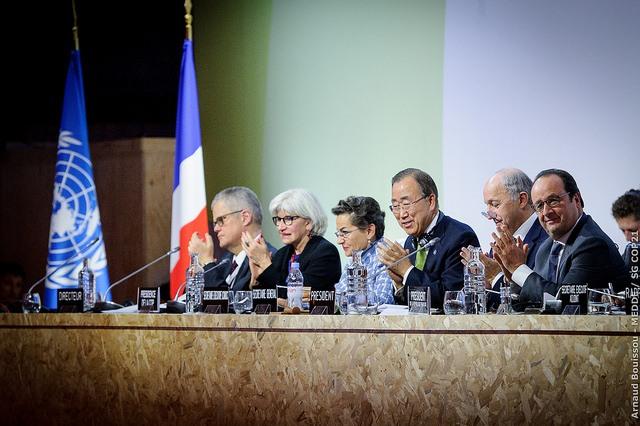

By Dr. Maximilian Martin
Two months ago, on Dec. 12, 2015, 196 countries representing 97 percent of world GDP agreed on ambitious, long-term carbon emissions reductions to contain global warming via the historic Paris Agreement.
A couple of interesting data points have come in since then. The day before the climate deal passed at COP21, the price of Brent crude oil settled at $37.36 per barrel, about a dollar above the $36.20 per barrel hit during the financial crisis. Two months later, it stood at $30.82. Brent crude oil prices are now forecast to average $38 per barrel in 2016 and $50 in 2017.
Oil prices close to a 13-year low are wreaking havoc on employment and investment in the petroleum industry itself -- forcing innovation and restructuring that could render procurement and production processes vastly more efficient. They also put public budgets in petroleum-exporting countries in the red and undermine the economic competitiveness of the current generation of renewables.
In the United States, the Supreme Court on Feb. 9 stayed the implementation of President Barack Obama’s efforts to curb carbon dioxide emissions from coal-fired power plants, while litigation with more than 30 lawsuits is ongoing. Associate Judge Antonin Scalia, who voted to block the plan, died on Feb. 13, resulting in additional uncertainty about the Supreme Court’s likely position on the issue going forward.
The latest U.S. Environmental Protection Agency (EPA) rule, which would require a 32 percent cut in power-plant carbon emissions by 2030 (based on 2005 emissions levels), may ultimately fail to stand. Whether the U.S. will ultimately be able and willing to deliver on the pledges made in Paris is one of the topics that will likely be decided at the next presidential election on Nov. 8.
The home of the energy transition, Germany, is in the meantime busy grappling with more than 1 million refugees seeking asylum and avoiding the implosion of the Schengen area. Wrestling with questions such as how to actually get 1 million electric cars onto German roads by 2020, which the government announced in 2011 to position the country as a market leader in e-mobility, risks taking a backseat.
For now, Germany continues to be highly energy dependent on Russia: 2015 set another record year of 45.3 billion cubic meters (bcm) of natural gas delivered by Russian firm Gazprom, up from 38.7 bcm the year before. German consumers now face among the highest electricity costs in Europe. Taxes and fees make up half the costs — seeing that the country’s energy-hungry industries are largely exempted from carrying the cost of the energy transition.
So, is the energy transition stalling? Not quite. It would be a mistake to underestimate the power of technology and innovation to keep driving nonlinear change toward a low-carbon economy. Oil companies know this and are working on carbon shadow pricing.
Don’t underestimate hardware and digital innovation
The big game-changers are the ongoing rise of digital and research breakthroughs that will make renewables cheaper. The closest thing to a silver bullet lies in the interplay of the innovation ecosystem and enabling regulation that clears the path to market.Thoughtful state intervention is essential if we want to get the market mechanism to work on the supply side of clean energy as well, and unlock its full disruptive power. This is key to driving down the cost of generation, storage and transmission through next-generation technologies. Some of these technologies already exist and are at varying distances from deployment. For storage, the Achilles heel of renewables, significant progress is only half a decade away.
The integration with digital will amplify all of this. Consider the storage capacity coming on stream if Germany were to reach its goal of putting 1 million electric cars on its roads by 2020. Vehicle-to-grid (V2G) capability illustrates the power of marrying digital with hardware, as discussed in my book, “Building the Impact Economy,” recently released by Springer. If swarm battery management — where batteries release electricity to the grid when it is needed and get charged when there is excess supply of electricity — becomes fully viable in scale on time, the implications would be powerful.
Even if a million of future electric cars in Germany only had today’s 125-kilowatt batteries, such as those found in the BMW i3, and 100,000 cars released electricity to the grid at any point in time, this would add up to 109,500 gigawatt-hours (in a year’s 8,760 hours). Under remote swarm management, electricity could be stored when there is excess supply of renewables in the grid, and discharged when there is net or peak demand.
Compare this to the next-generation French nuclear power plants of the 1,650 megawatt-equivalent (MWe) class in the European Pressurized Reactor (EPR) design. If the nuclear power plant runs 80 percent of the time, so 7,008 of 8,760 hours in a year, it produces 11,563 GWh. In other words, provided there are sufficient solar panels and wind farms to retrieve the energy in the first place and enough electric cars to store and release it, a large-scale swarm battery system in the electric-vehicle fleet could enable capacity that substitutes for about 10 nuclear power plants.
Now is the time to seed many more potential breakthroughs that are even wilder than this, complementing existing programs such as ARPA-E in the United States or Climate KIC in the European Union. Many things out there have hardly hit our radar. For example, just consider what would happen if a much more potent source of energy such as low-energy nuclear reactions became commercially viable. Or consider the medium-term implications of the Max Planck Institute’s Wendelstein 7-X fusion device: Six days before the U.S. Supreme Court decision, it produced its first hydrogen plasma. The scientists will now assess the setup’s suitability for use in a power plant that would derive its energy from the fusion of atomic nuclei — just as the sun and the stars do. (Should this work eventually, it would provide a defining answer to our need for low-carbon energy generation.)
Beware: It is a different ballgame for the G77
In emerging and frontier economies, the ballgame is different. Disruption is also needed in the 134 developing countries that are part of the G77. Change on the scale necessary to turn renewables into real 800-pound gorillas requires choices, money and technology transfer. To make progress faster, “scale-up-as-usual” will not be good enough. We also cannot provide endless amounts of money to subsidize the mainstreaming of renewables.
The $100 billion a year to help developing countries cope with climate change, which advanced economies committed to in Copenhagen in 2009 and in Cancun in 2010, are a good start, but alone will not do the trick. To seriously accelerate the energy transition here, it is essential to raise the investment path by several orders of magnitude — in ways that make economic sense, and that are adapted to the realities in advanced and developing economies.
The International Energy Agency estimates that implementing climate pledges (Intended Nationally Determined Contributions or INDCs) for COP21 would require the global energy sector to invest $13.5 trillion in energy efficiency and low-carbon technologies from 2015 to 2030, or 40 percent of total sector investment.
Take the example of Bangladesh, with 160 million inhabitants, the world’s eighth most populated country — and, at 1,100 people per square kilometer, also one of the most densely populated. Power outages were responsible for an output loss of nearly 3 percent of GDP in 2013 according to the World Bank Enterprise Survey. A majority of Bangladeshi firms has to invest in back-up generation, which adds costs to doing business. Energy demand is moreover projected to rise almost five-fold by 2030. Domestic gas production, the main source of energy, will decline as of 2019. I will leave it up to the reader to decide whether Rosatom’s planned two 1,200 MWe-class nuclear reactors 100 miles north of Dhaka, where 16 million people live — to come on stream in 2022 and 2023 — are, next to being a low-carbon idea, also a good idea.
However, what is for sure is that the Paris Agreement's implicit long-term goal of 100 percent renewable electricity needs to be seen in the wider context of Bangladesh’s rapid urbanization, which increases the need for energy and the country’s energy security. Under a business-as-usual (BAU) scenario, greenhouse gas emissions in Bangladesh in the power, transport and industry sectors are expected to represent 69 percent of total emissions by 2030. This is an increase of 264 percent up from 64 million metric tons of carbon dioxide equivalent (MtCO2e) in 2011 to 234 MtCO2e in 2030. The country’s INDC covers the power, transport and industry sectors and pledges:
- An unconditional contribution, which will reduce its GHG emissions by 12 MtCO2e by 2030 or 5 percent below BAU emissions — this while the population keeps growing.
- Further, the INDC targets a conditional 15 percent reduction in GHG emissions in the three sectors by 36 MtCO2e by 2030.
The commitment is subject to obtaining the appropriate international support in the form of finance, investment, technology development and transfer, and capacity building. Needless to say that we can hardly expect G77 countries to uphold their commitments should the U.S. not manage to uphold its own.
Moreover, to make this work in practice in Bangladesh and other G77 countries, a sort of “yin and yang” is needed. Advanced economies will need to transfer technology and invest. Moreover, Bangladesh will need to re-regulate its energy market in ways that are more attractive for foreign investment. This requires improving legislation and execution on public-private partnerships, corporate governance and transparency, so that multibillion-dollar investments funded by parties other than multilateral and bilateral donors become a practical possibility.
Where do we go from here?
The strong decline in energy prices makes it difficult to estimate the increase in demand. It will trigger investment cuts in fossil fuels that complicate any analysis of their future competitive position, especially in emerging markets. The likely net effect is that the agreed-upon targets must be more ambitious, as they do not sufficiently consider the surge in demand.
It is nevertheless time to separate news from trends and keep going. Research and technology will keep pushing out the possibility frontier. If in response to the Paris Agreement, OECD countries can take their clean=energy innovation R&D to the next level, and G77 countries focus on becoming fully investment-ready, by the time the next oil shock hits, the next 10 years have the potential to be the most exciting yet for anyone involved in clean energy as a scientist, entrepreneur, investor or member of civil society.
Image credit: Flickr/COP Paris
Maximilian Martin is the Founder and CEO of Impact Economy. Dr. Martin created Europe’s first global philanthropic services and impact investing department for UBS and the UBS Philanthropy Forum. In 2013, he wrote the primer on impact investing “Status of the Social Impact Investing Market” for the UK G8 social impact investment summit. His new book “Building the Impact Economy” shows how to reconcile responsibility with opportunity to seize the multitrillion-dollar opportunity of building a sustainable economy. Among other things, the book synthesizes insights from a review of over 9,000 cleantech startups and technologies.
H&M Wants to Revolutionize the Apparel Industry


Last week's Global Change Awards in Stockholm showed a window into Swedish culture. Crown Princess Victoria of Sweden presented the awards, beaming in a couture H&M gown after sitting for hours on a hard bench listening to the contest judges quibble over the finer points of systems thinking. She's nine months pregnant and even smiled politely when the master of ceremonies indicated that she looked about ready to pop.
The H&M Conscious Foundation gave away over a million euros -- no strings attached -- to five startup companies that prototyped technologies for improving the apparel industry’s environmental footprint. The award ceremony took place in the Golden Hall, where the Nobel Prize has been presented every year since 1901. We were there to eat dinner. After serving a five-course, vegetarian, locally-sourced meal for the hundreds of attendees who showed up an hour late (due to the aforementioned judges' quibble), the chef humbly presented himself to tell the story of the funny-looking carrots he’d included in course three and to explain that we were a much bigger crowd than he usually served in his 30-seat restaurant. Over dessert, I expressed bemusement to one of H&M’s PR reps about the emcee’s pregnancy gaff and she laughed, saying she appreciated his candor and the princess herself is quite good-humored.
I was in town to learn more about H&M’s sustainability program. Over my three days with the company, I found this same unusual mix of candor, understatement and delight imbued its business operations. It’s a mix that is certainly key to the company’s leading fashion empire – 3,900 stores and 142,000 employees. It is also key to the company’s sustainability performance – a performance which, humbly, appears to be seriously kicking sustainability ass.
Last year, H&M amended its business concept, “Fashion and quality at the best price,” to include “in a sustainable way.” That in itself is a huge change for a company that is not in the sustainability business.
At this time, none of the company's sustainability goals has a direct impact on the design process. The designers figure out what they want to produce for new seasons via a mix of trendcasting and customer feedback, and then they seek materials to make it so. “Doing something sustainable that isn’t fashionable isn't sustainable because no one will buy it,” explains Ann-Sofie Johansson, creative advisor and head of design, who has been with the company for over two decades. Instead H&M is using the circular economy to bring sustainability to the forefront.
Circular economy thinking, where waste equals food, is all the rage in Sweden, explains Amir Rashid, a researcher at the KTH Royal Institute of Technology and an expert on corporate implementation of closed-loop systems. “Most companies think this is a good way forward. But there’s a challenge with implementation because this is a radical way of thinking. When we are living in a linear environment, it’s a big adjustment. All the current tools are built for linear thinking." When making his business case for adopting circular thinking, Rashid points to economic opportunities like cost savings, product-development innovations and consumer appeal.
These are all the same levers H&M uses to manage the short-term costs of changing scope. In its case, product recovery and recycling to the fiber level are the challenges it is trying to overcome to make the joy of consumption guilt- and impact-free. H&M CEO Karl-Johan Persson is not scared to make his personal goals for an apparel industry sea-change public. In many ways, the company is "like Tesla,” he explains, admitting he’s a proud owner of one of the electric cars. Elon Musk's goals for a transportation industry overhaul mirror Persson's goals for fashion.
Of course, one wonders if an industry where growth means increased consumption can ever be truly sustainable. Persson agrees. “Do we really need all the things we buy? Of course not," he explains, gesturing around him. "We could do without this glass, this mobile phone; we could manage with out a lot of things.” However, he went on, “There is something good about economic growth.” If Ikea, for example, were to be shut down, “It would be very bad for the world. Jobs would be lost, people would have to pay more for furniture, and you would lose a big responsible company,”
In addition to spearheading efforts with the Sustainable Apparel Coalition to create the Higg index and set strong standards across the industry, H&M is taking things into its own hands, seeking a closed-loop system where the inputs -- cloth fibers – come from a renewable source – old clothes. It’s a big goal, and the company still has a ways to go.
H&M collected 20,000 tons of clothes through an in-store recycling partnership with I:CO. The donations are hand-sorted for reuse and recycling: Forty to 60 percent can be re-worn as-is and are sold on the secondary market (H&M donates the revenue to charity in local markets); 5 to 10 percent require a small repair (which I:CO manages); 0.30 percent can be upcycled into something more valuable while 30 to 40 percent are downcycled into something like insulation or another product.
This is by no means a closed loop, but it is the beginning of one. H&M has set a standard: “Fashion is a resource that can be used again and again,” explains Anna Gedda, head of sustainability at H&M. "It’s a new way of thinking about fashion.”
Indeed, the apparel industry needs to make some big changes. In addition to being materials-intensive, it requires a global supply chain packed with human rights issues from the cotton fields to the factory floor. H&M recently caught negative attention for a fire in a Bangladeshi factory as well as for Syrian children found working in a Turkish apparel factory. Persson explained that the company worked hard to mitigate these issues when they arose, phasing out the Turkish supplier and funding local NGOs to support the Syrian families that were caught in the middle. The reason H&M was singled out in a recent report, Persson claims, is because it is one of the few companies that makes its supplier list public.
Rather than integrate factories into its own supply chain, which might solve H&M’s people problem but would raise costs in the meantime, the company is working with the ILO to improve working conditions globally. While this approach is more time consuming, it presents a better opportunity to make lasting change. H&M has also lobbied governments in the countries where it contracts with factories to set strong workplace standards such as exist in Sweden.
H&M's big, hairy, audacious goal to revolutionize the apparel industry is laudable -- big thinking is something that we need in order to turn our path of over-consumption around and set a new standard. Let's hope other brands answer H&M's siren call.
Image credit: Jen Boynton
Travel and accommodations via H&M. Opinions are my own.
Seafood Origin Scrutinized Under Proposed U.S. Rules
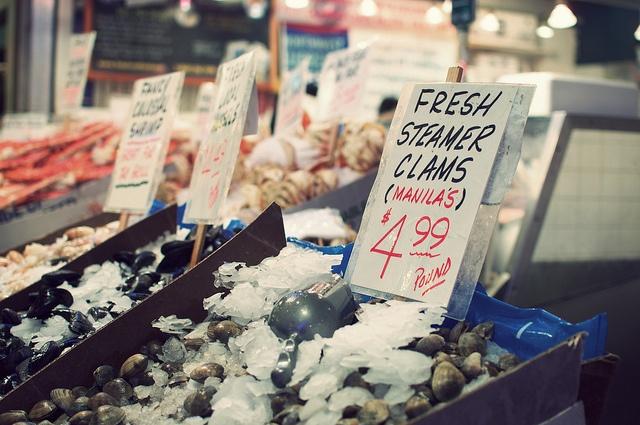

When you pay for prime dining at a seafood restaurant, do you know what you're really getting? How do you know that crab, swordfish or shark was legally and sustainably harvested? What if that red snapper isn't really snapper after all?
A proposed new set of rules would make it harder for seafood gained through illicit means to end up in United States commerce.
The National Ocean Council Committee to Combat Illegal, Unreported and Unregulated Fishing and Seafood Fraud proposed a new U.S. seafood traceability program this month. The committee spans the U.S. Department of Commerce, the National Oceanic and Atmospheric Administration, and several other federal agencies all working together on this global problem.
When seafood is not accurately traced, it leaves room for food-safety questions, sustainability challenges and even fraud. “This proposed rule is a critical first step in our efforts to create a comprehensive traceability program designed to prevent products from illegal and fraudulent fishing entering U.S. commerce,” said Catherine Novelli, U.S. under secretary of state for economic growth, energy and the environment.
A 2013 report by the conservation group Oceana drew attention to the seafood fraud problem by finding that a third of seafood samples it tested were mislabeled. At that time, red snapper, for instance, was discovered to be frequently mislabeled when it was really another fish.
The new rules would require detailed information about the origin of seafood products harvested abroad and chain-of-custody information. Similar details about the origin of food are already required of seafood considered to be domestic. According to government statistics, U.S. fisheries alone land some $5.5 billion in seafood each year. So, the potential for mislabeling and fraud could significantly impact the market for the more scrupulous seafood producers.
Officials are looking at whether some third-party reporting programs could satisfy some of the reporting requirements under the proposed new rules. There is still room for revision in the rule-making process, they said.
The list of aquatic species considered at risk and to be identified through the new program include these considered to be most vulnerable:
- Abalone
- Atlantic cod
- Blue crab
- Dolphinfish
- Grouper
- King crab (red)
- Pacific cod
- Red snapper
- Sea cucumber
- Sharks
- Shrimp
- Swordfish
- Albacore tuna
- Bigeye tuna
- Skipjack tuna
- Yellowfin tuna
The proposed rules follow on the heels of a proposed action-plan last year by the Presidential Task Force on Combating IUU Fishing and Seafood Fraud. The task force identified these key concerns about seafood entering the United States:
- Enforcement capability
- Species misrepresentation
- Catch document scheme
- History of fishing violations
- Complexity of the chain of custody and processing
- Mislabeling or other misrepresentation
- Human health risks
Citizens and businesses organized loosely via the Oceana organization previously urged the president and Congress to address the need to trace seafood and prevent fraud in this industry. Oceana promotes policies to protect the oceans and make fishing more sustainable. It also encourages the purchase of fish products that are least likely to harm the sustainability of the oceans.
These proposed rules would also help the United States cooperate more fully with international trading partners in ensuring a robust seafood trade. According to the White House, illegal, unreported and unregulated (IUU) fishing can mean a loss of between $10 billion and $23 billion in global revenue each year.
NOAA is asking for input from the seafood industry, conservationists, and all those involved in domestic and international trade as the rules are finalized.
A public 60-day comment period will remain open on this new rule until April 5, and the public can participate via a series of webinars hosted by NOAA Fisheries and the State Department in February and March. Detailed information is available at this government website.
Image credit: Flickr/John Tornow
Forest Protection Groups Ask EU to Exclude Biofuels
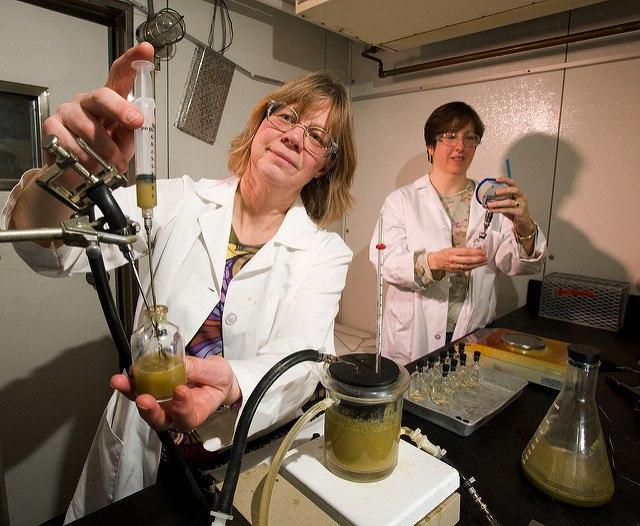

Last week, a group of 125 organizations from 45 countries signed a declaration asking that the European Union exclude large-scale biofuels from its next Renewable Energy Directive (RED).
Among the signatories are Biofuelwatch, Center for Biological Diversity, Food and Water Watch, Gaia Foundation, and the World Rainforest Movement. The declaration asks that the EU “exclude bioenergy from its next Renewable Energy Directive, and thereby stop direct and indirect subsidies for renewable energy from biofuels and wood-burning.”
The declaration further states: “The EU claims to have a very ambitious climate policy and emission reduction targets. But this claim is built on the false premise that large-scale bioenergy is inherently carbon neutral, or at least 'low carbon.' A growing body of evidence, however, shows that, especially when bioenergy is produced and used on a large scale, it tends to increase rather than decrease carbon emissions when compared to fossil fuels.”
While the declaration itself is short on specifics, a linked supporting document focuses primarily on the widespread use of wood pellets for power generation and palm oil for biodiesel, and the impact of these two energy sources on forests and the communities that depend on those forests. The signatories also link to the World Rainforest Movement, an organization that cites concerns about the administration of the United Nations' REDD+ program, which was specifically developed to protect forests.
From the U.N.: “Reducing Emissions from Deforestation and Forest Degradation (REDD) is an effort to create a financial value for the carbon stored in forests, offering incentives for developing countries to reduce emissions from forested lands and invest in low-carbon paths to sustainable development. 'REDD+' goes beyond deforestation and forest degradation, and includes the role of conservation, sustainable management of forests and enhancement of forest carbon stocks.”
So, we have two groups that both claim to share the same concerns but differ widely as to how best to go about addressing them. The forest-protection groups cite examples in which efforts to protect forests through carbon-credit programs like REDD+ are counterproductive in places like the Congo and Costa Rica. They question assumptions made by agencies acting under REDD+, and challenge their basis for assigning credits for preventing deforestation. Furthermore, they assert that locals have not been involved in the process and receive little or no benefit, despite claims to the contrary, and that deforestation actually soared during the period in question.
It underscores the fact that these intervention efforts by well-meaning entrepreneurial outsiders, who see an opportunity to do some good or make a few bucks (or perhaps a little of both), often fall short because of their failure to comprehend the complete picture.
But if oversimplification is the sin of those who would come in and attempt to solve complex problems with simple solutions, it is also the sin of those who would ban all such attempts with a single stroke of the pen. To eliminate all large-scale biofuel production from consideration as renewable energy is to overreact to a few bad experiences and to throw out the baby with the bathwater.
While it’s true that biofuels could be considered less renewable than sunshine or wind, in that it takes longer for the fuel to be renewed, it is clear that they are many, many times more renewable than the fossil fuels they replace. While those good folks wearing environmental hats, passionate in their desire to protect nature from human greed, oppose the idea of industrial agriculture (or anything with the word 'industrial'), it’s pretty clear that this is an approach that unduly limits our options as we try to rapidly transform our economy to a more sustainable one.
There is a presumption here that small-scale efforts tend to be cleaner and greener than large scale. That has not been documented and is certainly not always the case. But even if it were, it’s unlikely that small-scale efforts alone are enough to get us where we need to be in the little time we have remaining. Is this not another case of letting the perfect get in the way of the good?
Biofuels may or may not ever be perfect, but there are several reasons why they should be included as an important aspect of any renewable portfolio. First, while most renewables like solar and wind are useful for electricity, they don’t directly feed our transportation needs without a massive overhaul of the entire system. Liquid fuels not only provide more energy per pound, but also fit seamlessly into our existing infrastructure. The current regimen in the U.S., while not without its problem, very quickly enabled us to cut gasoline consumption by 10 percent by supplementing it with ethanol. Early reports showing that first-generation, starch-based ethanol produced more carbon than gasoline have been discredited, and efficiencies in both crop production and conversion process have only improved since then.
Biofuel production processes that are carbon-neutral and even carbon-negative have already been demonstrated and are beginning to scale up.
The path to a sustainable energy future will undoubtedly be filled with numerous potholes, detours and dead ends. Efforts that can't deliver intended results need to be recognized as such and appropriate actions taken. We have no choice but to use the tools available, including certifications, though the EU declaration argues against this approach. Wood pellets and palm oil needed to be looked at carefully. Most important of all, though, we need to recognize that we don’t have the luxury to rule out an entire category of energy sources on the basis of a few bad experiences.
Image credit: Flickr/U.S. Department of Agriculture
Paving the Way for a Circular Economy
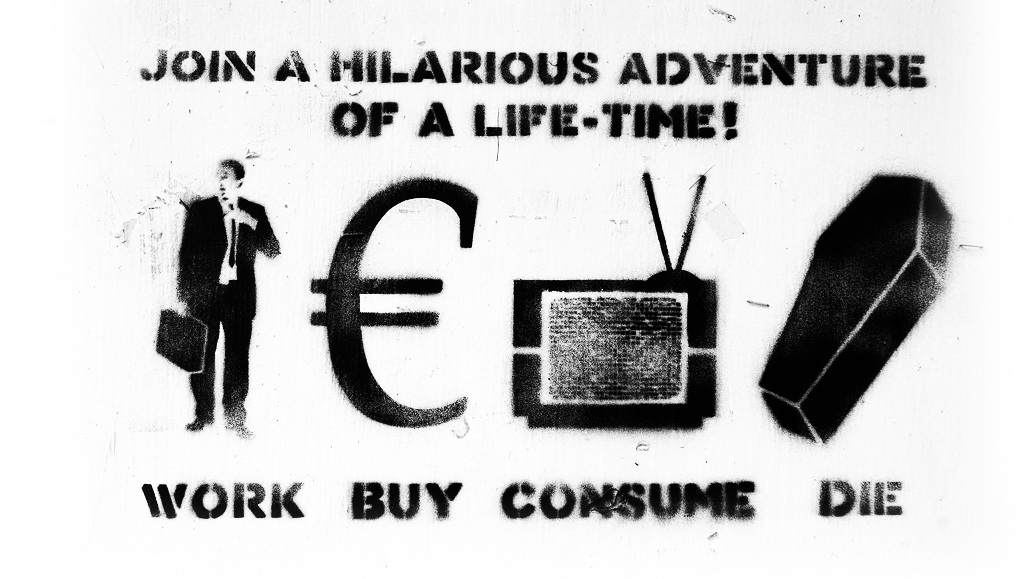

By Averill Brewer
There is a morbid depiction of human life floating around the Internet that reads something like: “Join a hilarious adventure of a lifetime! Work. Buy. Consume. Die.” Although this is a pretty robotic portrayal of modern human existence, and quite obviously does not account for the aspects of life that inspire pleasure and hopefulness and creativity, it is a useful picture in understanding our current system of consumption — the linear economy.
One of the best definitions of a linear economy is provided by the Ellen MacArthur Foundation, which also defines the antithesis of a linear economy, the circular economy. According the foundation, today’s “linear take, make, dispose economic model relies on large quantities of cheap, easily accessible materials and energy." Our current linear economy is one that has reached a tipping point, due its reliance on finite materials and “throw-away” methods combined with exponential population growth and the resulting consumption rates. The bubble will burst.
The hero of our story -- its concept still fairly young -- is called the circular economy. The circular economy resolves the negative consequences of our current system by providing a framework that creates an economy which is “restorative and regenerative by design, and aims to keep products, components and materials at their highest utility and value at all times.” All waste materials are recycled in or composted never reaching a grave.
There is no need vilify sudden uncomfortable changes. Nobody wants to be left behind because regulators and public policies inhibited them from “keeping up”, whether it is technological change or transforming into the circular economy. We must remember that as stakeholders, we have the unique ability to create the strong pull needed to incentivize our institutions and businesses to make decisions that are tied to circular economy principles. It is our compassion and stewardship qualities that differentiate us from robots—qualities that during times of rapid change we must be careful to nurture and use to our advantage to create a more sustainable world.
In January, the world’s leaders in economics, business and government met at the annual World Economic Forum (WEF) in Davos, Switzerland. The theme this year was the "fourth industrial revolution," meaning the global, exponential pace of transformation in entire systems of production, management and governance due increasing digitization, automation and artificial intelligence on a massive scale. Jobs will be lost because of this technological revolution, as was the case with all previous industrial revolutions. Humans will continue to adapt and to conceive new relationships with technology.
Nicholas Davis, head of society and innovation at the WEF, said: "It shouldn’t be too shocking that two Oxford researchers, Carl Benedikt Frey and Michael A Osborne, estimated that 47 percent of U.S. jobs are at high risk from the changes underway in digitization and automation.”
Of course, it is too soon to frantically speculate about the consequences of the fourth industrial revolution. It is also perhaps alarmist behavior to assume, even if automation and robots take over a large quantity of monotonous jobs, that there will not also be jobs created to compliment new technologies we can’t even image yet. For a very simple example: The plane was created and then the pilot was needed.
Without the transformation of our current linear economy into a circular economy, there is no way to root real progress in sustainable development. Government policies and incentives have begun to create the “push” needed for this transformation, Jean-Louis Chaussade of Suez Environment said during a briefing at the Davos Conference. However, it is up to stakeholders to create a strong pull and demand for companies to utilize circular-economy principles. In Chaussade’s industry, such a pull might look like stakeholders who are demanding that manufacturers use the available technology to produce “second-hand/recycled plastics” versus their current production of virgin plastic derived from fossil fuels. A strong pull and demand from consumers is necessary in order to compete with the $30/barrel oil prices.
In December 2015, the EU Commission adopted the Circular Economy Package, signaling that European bureaucracy views the circular economy as the vehicle the European Union needs in order to help businesses and consumers move forward while using resources in more sustainable way. The objective of the Circular Economy Package is that along with creating substantial environmental benefits, a growing circular economy will offer the “potential to create jobs, differentiating itself from other industrial revolutions” because the circular economy will use more labor and fewer resources to “increase efficiency in economic activity.” The main sectors of the circular economy, which the European Commission has identified as potentially contributing to job creation in the future, include the repair, waste and recycling, rental & leasing sectors.
The report projects circular-economy activities to create at least 3.4 million jobs across Europe: 1.2 million in repair of machinery; 400,000 in repair of computers and household goods; 700,000 in waste collection, treatment and disposal, etc. Researchers warn that the technological revolution can potentially disrupt these projections due to the uncertainty of what automated systems will be able to replace.
If the unknown potential of the fourth industrial revolution is what makes it exciting... then the tangible and measurable goals of the Circular Economy Package are what create a responsible path for the future. The Circular Economy Package “gives a signal to economic operators that the EU is using all the tools available to transform the economy, opening the way to new business opportunities and boosting competitiveness” in addition to creating jobs and generating sustainable growth.
Image: Public domain
Averill Brewer is a writer currently living in England. This autumn she completed her master's of international business with a focus in sustainable development. You can email her at [email protected]
4 Steps to Turn the CEO’s Vision Into Reality


By Carey Rome
Execution can make or break any CEO. The inability to execute on vision and strategy results in an estimated 70 percent of all CEO failures.
It was one of the reasons Leo Apotheker was ousted from Hewlett-Packard. The same could be said for Ron Johnson’s removal at JCPenney and Carol Bartz’s demise at Yahoo.
But the responsibility of envisioning, developing and executing a company strategy doesn’t rest just with the CEO; it’s a challenge for the entire executive team. And because the CEO’s success or failure depends greatly on the C-suite executives beneath him, these executives necessarily share in the consequences of success or failure.
In 2007, Harvard Business Review analyzed executive turnover, and the findings were clear: CEO turnover drastically increases executive management turnover, with about 20 percent of upper managers exiting with the CEO. So, the pressure to succeed doesn’t rest solely on CEOs, and those who wait for directives will quickly find themselves falling behind.
Obstacles facing CEOs
The very structure of today’s companies can pose challenges for CEOs and the executive teams beneath them. Although a department-first focus is necessary for CMOs, CFOs, CTOs and the like, it can also lead to dangerous silos. Engineering challenges are important for marketing and sales teams to know, and improper interdepartmental communication can result in frustrated customers with outdated or incorrect information. Without a CEO’s top-down view, these inadvertent silos can cause strategic blunders and lost revenue.
Organizations also run into problems when executive teams attempt to protect the CEO from the truth. Too many executives water down issues, failing to see that bluntly relaying challenges to the CEO is the best way to support the company.
Enabling CEO success
Considering the challenges your CEO faces, how exactly should you collaborate with him to position the company for a more successful future?
1. Understand and clarify the CEO’s vision
To appreciate how your efforts might affect other areas of the organization, your CEO’s vision must be clear to the entire C-suite. This understanding will inform how you execute your department’s role in that vision.
I use a process I call the “Four C’s for Clarification” to help CEOs explain their visions to executive teams. The first step is capture: Ask the CEO to describe his vision as he might to an architect building his house. What is his big-picture view? As an upper manager, it’s then your job to fill in the actionable details — just as the architect of a house makes executive choices about details such as room dimensions or roof slope.
Context is the second C: Why does the CEO think a certain strategy is the right move? By having her explain her decision-making, the entire executive team gains deeper insight into the reasoning and goals behind a given strategy.
The third is clarity: C-suite members should individually discuss their departments’ action steps with the CEO. This helps identify any potential pitfalls, interdepartmental ripples or money sinks the plan might create.
Last, seek cohesion: Once the CEO’s strategy and action plan is developed, it’s time to get every team member on board. How can your department (and the entire organization) function as one to implement the CEO’s plan?
2. Deliver on that vision
Talking strategy is never enough; you must be able to execute on it. Demonstrate a true understanding of the CEO’s vision by developing and circulating a plan that executes your part of it — and doesn’t sabotage the management efforts of other areas in the process, of course.
I recently attended an executive team workshop for one of my clients. The CEO originally wanted to diversify one action-step into three distinct campaigns. I disagreed with this strategy, but rather than speaking up myself, I prompted his team members for their ideas. They overwhelmingly agreed with my own assessment, and that was to eliminate the other two distractions and give focus to a single course of action.
The best thing you can do to support the CEO at this stage is to guard against pet projects and distractions. Returning to the residential-construction analogy, actually building the house should be the team’s first and foremost priority. Side projects, such as landscaping, might raise the home’s value, but they’re meaningless until the house itself is built.
Projects tend to lose cohesiveness and sap resources when distractions are allowed to grow, often hamstringing the company’s ability to deliver on the CEO’s vision.
3. Straightforwardly communicate challenges
You’re not doing anyone any favors by sugarcoating issues. Notify CEOs of any challenges, and do it in three phases. Start with a general warning of potential problems. Then, outline what you’re doing to gather the facts and when the CEO can expect these facts. Last, offer up your solution to the problem.
One very real danger while communicating challenges is adding complexity. While you might view it as giving context, the CEO is likely to get hung up on peripheral distractions rather than the single decision to be made. Instead of giving too much context, ask yourself: What’s the root cause of this issue, and what is the decision to be made? Realize the CEO is busy and that smaller concerns can wait for another day.
4. Own your leadership role
Play your part and take full ownership of your leadership responsibilities. Strong leadership requires the courage to ask for additional resources when you need them, to deliver bad and good news with equal fervor, and to admit mistakes before they snowball into companywide catastrophes.
Always offer solutions. If you just relay problems to the CEO with no ideas on how to fix them, then you won’t be long for the job. Instead, be specific: If a project requires additional funds, then say so explicitly and calmly. First, describe the unexpected costs. Next, explain why your project merits the funds. Finally, make a clear request: How much money do you need, when do you need it, and what will the expenditures accomplish?
It’s your responsibility to add value to the organization, and there’s nothing more valuable to a CEO than an understood vision and a well-executed plan. Don’t wait to be led. Step up and lead in both good times and bad. Real value and growth come in our most challenging moments.
Image credit: Pixabay
Carey Rome is the founder and CEO of Cypress Resources, a management consulting firm based in Birmingham, Ala., with more than 15 years of experience helping business executives reach their goals. He has served as an adviser to business leaders at mid-sized to Fortune 1000 companies.
Crawl-Walk-Run: Actionable Steps to Sustainable Sourcing for Private Brands


This is the second post in a four-part series on undertaking a sustainable-sourcing business approach to innovate private store brands. Click here to view section one about the myths, risks and opportunities of sustainable sourcing. Here we'll explore the Crawl Phase.The upcoming sections will explore the Walk Phase and the Run Phase of the innovative Crawl-Walk-Run approach.
In an economic climate with relatively stagnant growth for major national brands, private brand sales in all major retail channels continue on an upward trend. Sustainable sourcing, generally defined as using a resource so that it is not depleted or permanently damaged, creates an opportunity to differentiate your private brand from the competition, while providing additional value to your customer.
If you are just beginning the journey into sustainable sourcing, I recommend taking a Crawl-Walk-Run approach.
Where to begin: Crawl
Recycling: To begin, focus on quick wins like adding recycling instructions to your packaging as you update current labels or develop new packaging. According to National Geographic’s Greendex, the U.S. makes up 5 percent of the world’s population and creates half of the world’s garbage. Adding clear recycling instructions will make your private brand's product remain relevant to current customers while appealing to new sustainably-savvy customers.Another quick win is to get your organization involved in recycling. Partner with local waste management companies on recycling programs that reduce costs or even generate revenue.
Food waste: Partner with local food bank organizations like Feeding America in order to reduce food waste from overruns, short-coded product or damaged product.
In the U.S., 40 percent of all food ends up in landfills. Let’s talk about donating that food. While some private brand owners remain hesitant about sending their products to food banks because of liability or consumer concerns, U.S. legislation offers brand owners liability protection in the Bill Emerson Good Samaritan Act.
What about meat donations? A recent USDA change has made this easier. Food banks have the ability and are required to relabel any missing ingredients or unlabeled allergens. Food banks can receive large quantities of animal proteins and will follow the same regulated safe handling protocols to repack product into smaller quantities to be distributed to clients.
As with all sustainability initiatives, it is very important to let your customers know about your programs and give them stories and examples of how these programs are helping local communities. Many food banks can help with promotions and are eager to share information of your partnerships with the press or online social media. For you, there are tax benefits to donating, reduced trash costs and, of course, the goodwill factor that identifies your brand as helping feed the hungry across America.
Animal well-being: Another initiative to begin in the Crawl Phase is to request third-party animal welfare audit results from your animal protein suppliers and manufacturers. Most suppliers already undergo third-party processing plant inspections using the North American Meat Institute (NAMI) animal welfare audit designed by Dr. Temple Grandin. It may be more difficult to obtain on-farm animal welfare audits, but it is important to start the discussion by asking for them so your suppliers know your company wants to begin receiving the information on a regular basis.
Once you have established this audit request process, you will need to ensure audit compliance reviews and corrective action follow-up. It is crucial to let your suppliers know that if there are audit deficiencies, you expect them to identify these and take corrective action, even if the audit is passed.
Communicating expectations of suppliers is key to ensuring a smooth process. Sustainable Solutions Group has this program in place and guides large retailers and foodservice companies in making this audit review process thorough and efficient.
Supplier diversity: Begin to actively seek supplier diversity in RFPs/RFQs so that private brand manufacturer diversity can be part of your socially responsible sustainable sourcing platform. If you are not doing this already, begin by buying at least one product from minority-owned or women-owned manufacturers. It may be less than a truckload, but it does not require you to do any more than award the business, while providing an opportunity to innovate your private brand.
Customer communication: Last but not least, make sure you begin promoting these efforts through social media, point-of-sale materials in-store, and messaging on your website.
Portions of this were originally published in Henry Stewart Publications 2045-855X Journal of Brand Strategy VOL. 4, NO. 2, 000–000 Summer, 2015
Image credit: Flickr/Leszek Leszczynski